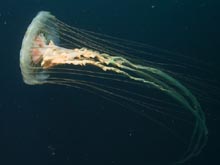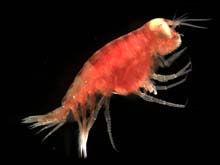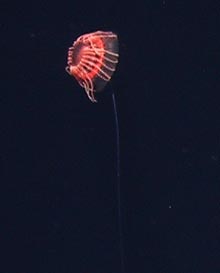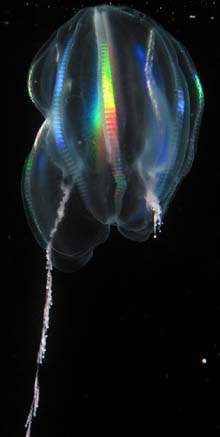
The scyphomedusae Chrysaora melanaster was common in the near surface waters. These jellyfish have a bell approaching 30 cm across and have tentacles that can stream out from behind the animal for 3-6 meters. (Photo by Kevin Raskoff, MBARI.) Click image for larger view.

The midwater amphipod species Cyclocaris guilelmi collected by the ROV. (Photo by Russ Hopcroft, UAF.) Click image for larger view.
An ROV Dive
August 31, 2002
Russ Hopcroft
University of Alaska Fairbanks
Today we prepped the remotely operated vehicle (ROV) for a pelagic dive. We dropped the ROV into the water and released it from the crane’s hook. Since the last dive, we had reduced the view angle on the main video camera, and installed one-quart juice cans over two of the ROV lights to produce a more spot-light-like illumination. Both these changes would help improve our ability to see the gelatinous zooplankton during the dive.
Immediately after we released the ROV, we noticed that there were large numbers of ctenophores in the upper 10-20 m of the water column. Mixed in with them were the large jellyfish Chrysaora similar to the one we had encountered on our first dive. It was tempting to spend time looking about in this layer, but we decided it was better to move onto to deeper waters first, leaving time to explore the near-surface waters at the end of the dive. The lighting was a notable improvement. Like the first dive, numerous smaller zooplankton and marine snow swirled past the cameras as we descended.
The strategy for this dive was to make periodic stops for 10 to 20 minutes every 300 to 400 m so that we could then target the most interesting depths for longer exploration during ascent. Our first real stop was just below 300-meters depth. There was not much new here, other than the odd larvacean and the odd hydromedusae Botrynema ellinorae.Down we plunged, stopping at approximately 700 m. The Botrynema were now being replaced by another hydromedusae - Sminthea arctica. As we spent time at this depth, we noticed an increasing frequency of bright-orange amphipods around the ROV. It was soon clear that the ROV’s lights attracted them. This was a great opportunity for us, so we turned on the suction sampler and collected a number of them in the sampler buckets. Soon, it was time to move on.
As we passed through 1,000 m, we spotted something familiar—the red dome-shaped hydromedusae Atolla tenella (see image at right). We stopped deploying cable, and leveled off at 1,050 m. We were excited about the possibility of collecting an Atolla to confirm if it is the same species as that found in Monterey Bay, California. I tried to advance the suction sampler to a new canister, but nothing happened. I pushed the control back and forth several times without success. Suddenly, I realized that mud was appearing in the mini-camera that was focused on the sampler. Every time I tried to activate the piston, mud would appear, which was a bad sign. If a hydraulic line had burst, this is what I would see. After a few more attempts at advancing the sampler, it was confirmed that this was indeed what had happened, forcing us to abandon use of the sampler for the remainder of the dive. We turned our attention back to the cameras, disappointed that we could collect nothing more during the dive. After a few more minutes of looking around, we pressed onward and deeper.

The midwater hydromedusae Atolla tenella. Notice the characteristic trailing of one tentacle that is much longer than the rest. (Photos by Kevin Raskoff, MBARI.) Click image for larger view.

Light refracts off the comb-rows of the ctenophore Mertensia ovum producing stripes of rainbow color. One of the two tentacles with which it feeds is deployed while the other is retracted. (Photos by Kevin Raskoff, MBARI.) Click image for larger view.
There was a brief stop at approximately 1,500 m. Just over three hours into the dive, we reached the bottom at 1,860 m. We couldn’t resist the temptation to look around the bottom for half an hour or so. Generally, there is normally an accumulation of pelagic animals just off the bottom, but oddly enough, we saw nothing obvious here. Even the large red jellyfish (possibly a Crossota species) that we had seen on the prior benthic dive were absent from this location.
Our curiosity about the near bottom satisfied, we began the slow climb back toward the surface. Sminthea arctica’s range had extended all the way to the bottom. We were quite surprised by the frequency with which we encountered Atolla between the bottom and about 1,000 m. Even by standards from other oceans, they were unusually abundant. Between 1,000 m and the surface waters they were replaced first by the relatively transparent hydromedusae Sminthea arctica, and then by Botrynema ellinorae.
We reached the near surface waters at 6:00 pm. We had no trouble locating the Chrysaora that we had seen earlier in 20 to 30 m of water depth. They were great subjects for video and still photographs. We climbed a little shallower, and found the layer rich in the ctenophores Mertensia ovum and Bolinopsis vitrea, where Chrysaora is relatively rare. The existence of such distinct layers by the two species presented an interesting question. We speculated that the ctenophores might be avoiding predation by the Chrysaora by hiding in the fresher, shallower waters, which perhaps the Chrysaora might be less able to tolerate.Time passed quickly for us as we hovered in these jelly layers. All too soon, the dive was over. We hit the deck at 7:30 pm. Inspection of the ROV confirmed our suspicion that we had a hydraulic leak. A seal had split in the piston that advanced the suction sampler, ultimately preventing any more collection on latter dives. We removed the suction sampler buckets, which held eight bright-orange, deep-water amphipods. The animals were stored in the cold-room until they could be photographed.
Although there were problems, overall, we felt good about the dive. Despite a few rough edges to still overcome, the ROV was showing promise as a tool for midwater observation and collection. This was no small accomplishment for a vehicle only on its third operational dive, trying to accomplish tasks normally undertaken by larger and more “mature” ROVs.
Sign up for the Ocean Explorer E-mail Update List.


























